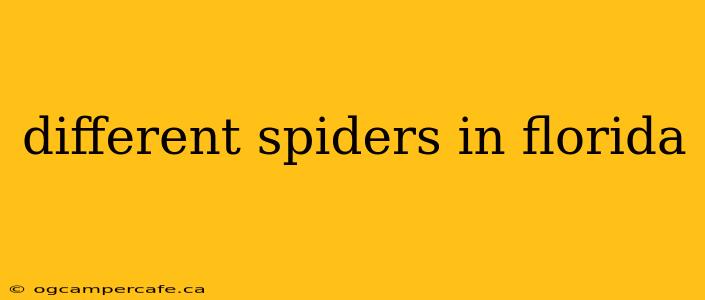Florida's warm, humid climate provides a perfect habitat for a diverse array of spider species, some harmless and others potentially dangerous. This guide explores some of the most common spiders found throughout the Sunshine State, highlighting their identifying features, habitats, and potential risks. Understanding these arachnids can help you coexist peacefully and safely.
Common Florida Spiders: Identifying Characteristics and Habitats
Florida's spider population is vast, but some species are more frequently encountered than others. Let's examine a few:
1. Black Widow Spider ( Latrodectus mactans):
- Identifying Features: Easily recognizable by its shiny black body and a distinctive red hourglass marking on the underside of its abdomen. Females are significantly larger than males.
- Habitat: Prefers dark, secluded areas like woodpiles, sheds, garages, and under rocks. They often build irregular webs in these locations.
- Potential Risk: The black widow's bite is venomous and can cause severe pain, muscle cramps, nausea, and other systemic symptoms. Seek immediate medical attention if bitten.
2. Brown Recluse Spider (Loxosceles reclusa):
- Identifying Features: Characterized by a dark brown violin-shaped marking on its cephalothorax (the fused head and chest region). It has six eyes arranged in pairs.
- Habitat: Prefers dry, dark, and undisturbed areas, similar to black widows. They are less common in Florida compared to other states, but sightings do occur, especially in northern parts of the state.
- Potential Risk: The brown recluse's bite can cause a necrotic lesion (tissue death) at the bite site. Medical attention is necessary to manage the wound and prevent complications.
3. Orb Weaver Spiders (Family Araneidae):
- Identifying Features: A large and diverse family, orb weavers are known for their intricate, spiral-shaped webs. Their size and coloration vary greatly depending on the species. Many are brightly colored and relatively large.
- Habitat: Commonly found in gardens, bushes, and around homes, where they construct their webs to catch prey.
- Potential Risk: Generally harmless to humans. Their bites are rarely painful and typically cause only minor irritation.
4. Jumping Spiders (Family Salticidae):
- Identifying Features: Small to medium-sized spiders with excellent eyesight and remarkable jumping abilities. They are often brightly colored and have hairy bodies.
- Habitat: Found in a wide variety of habitats, including gardens, forests, and homes.
- Potential Risk: Completely harmless to humans. Their bites are not medically significant.
5. Wolf Spiders (Family Lycosidae):
- Identifying Features: Large, hairy spiders that hunt their prey rather than building webs. They have eight eyes arranged in three rows.
- Habitat: Found in various environments, including fields, forests, and sometimes indoors.
- Potential Risk: Though they possess fangs and can bite, their venom is generally not dangerous to humans. The bite might cause mild pain and localized swelling, similar to a bee sting.
Tips for Coexisting with Florida Spiders
While some spiders pose a threat, most are beneficial and play a crucial role in controlling insect populations. Here are some tips for minimizing encounters and ensuring safety:
- Maintain a clean and tidy home: Reduce clutter, seal cracks and crevices, and regularly clean out sheds and garages to eliminate spider habitats.
- Use caution when handling firewood or debris: Always wear gloves when moving objects that could harbor spiders.
- Be aware of your surroundings: Pay attention to where you place your hands and feet, especially in dark or cluttered areas.
- Seek medical attention if bitten: If you suspect a venomous spider bite, seek medical attention immediately.
This guide provides a basic overview of some common Florida spiders. Remember that many other species exist, and proper identification is crucial for determining potential risks. If you're unsure about a spider's identity, it's always best to err on the side of caution and avoid handling it. Contact your local extension office or pest control professional for assistance with identification or spider control.
